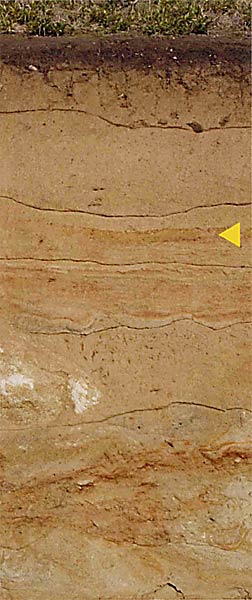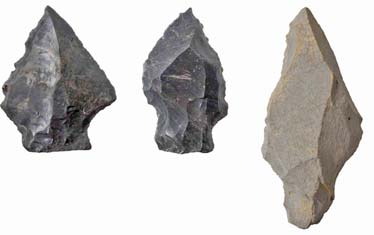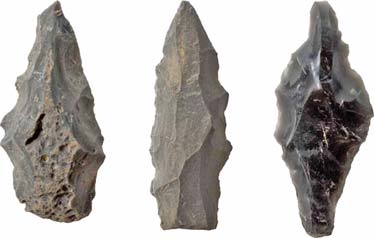Jizōdaira:
Stone tools for hunting are recovered in great numbers above and below AT volcanic ash. The chronological age is certain, and signs of overcoming the catastrophe are also clear.
 AT volcanic ash deposition The Aira Caldera, which formed part of modern Kagoshima bay, erupted about 28,000 years ago, spewing ash (the layer marked with the yellow arrow) that has been found from Kyushu to the Kantō region, and as far away as the Korean peninsula and mainland China. AT is the code used in geology to indicate this layer. The red brackets on the left border of the photo show the ranges where stone tools are found. |
 The site from a distance (from the south) The site (marked with yellow circles) is located atop a river terrace at the confluence of two streams in the upper Kase river basin. Excavations were carried out from the 2006 to 2010 Fiscal Years in conjunction with the construction of a dam on the Kase river. |
 Principal Paleolithic sites (marked ●) of northern Kyushu, plus main sources of stone material (marked ▲ for andesite, ◆ for obsidian) |
Jizōdaira Site, Saga City, Saga Prefecture
Stone tools recovered above and below Aira-Tanzawa volcanic ash
Jizōdaira is a site of the Upper Paleolithic period (35,000 to 16,000 years before the present) located at about 300 m elevation atop a river terrace in the upper basin of the Kase river which flows into the Ariake Sea. Pits, concentrations of stone tools and tool-making materials, stone clusters, and roughly 47,000 stone tool flakes were recovered.
As these stone tools came from multiple strata both over- and underlying volcanic ash from the huge eruption around 28,000 years ago of the Aira Caldera in Kagoshima (the Aira-Tanzawa, or AT, volcanic ash layer), they are a precious find corresponding to the period from around 32,000 – 16,000 years before the present.
Stone tool making with lithic material brought from various locales
Among the recovered tools were knife-shaped stone tools, plus end scrapers and projectile points made from flakes; in addition, raw lithic material for tools and stone cores from the tool-making process were found in great numbers. Among these finds, items used for spears as hunting weapons are plentiful, with a volume far exceeding any other in Kyushu. As lithic material for the tools, there is obsidian from Mt. Koshi in the city of Imari and andesite from the municipalities of Ogi and Taku, nearby in Saga prefecture, plus obsidian from the city of Sasebo in Nagasaki and the town of Oguni in Kumamoto prefectures, brought from 80 km away.
It can be seen that this site was a base camp for hunting for the people of the Upper Paleolithic period.
Post-eruption survival and residence
It was previously thought that the Aira Caldera eruption was of a scale that brought ruinous damage to Kyushu at the time. But from the recovery of stone tools in strata both above and below the deposited volcanic ash, it is now known that at least in northern Kyushu, people survived the calamity of the great eruption and continued their activities. (Shirakihara Takashi)
(principal artifacts, Jizōdaira Site)
 Projectile points from flakes Upper Paleolithic, approximately 25,000 years ago. Length: 4.2 – 9.4 cm. Stone tools with notches made on both sides of the base and pointed at the tip, they were attached to the ends of spears and used for hunting. These tools appeared after the deposit of the AT layer. They are made of andesite and obsidian. In addition, the site yielded trapezoidal tools, end and side scrapers, burins, and drills. |
 Knife-shaped stone tools Upper Paleolithic (approx. 32,000 – 20,000 years ago). Length: 4.2 – 5.0 cm. These are stone tools with very sharp blades and thin, pointed tips, used as knives or as hunting implements attached to the end of a spear. They are recovered from both above and below the AT layer. The items shown here are made of andesite and obsidian. |
 Pyramidal-point stone tools Upper Paleolithic (approx. 30,000 years ago). Length: 5.8 – 6.2 cm. This is a type of hunting implement attached to the end of a spear and made with an edge like the teeth of a saw. These tools appeared after the deposit of the AT layer. The items in these photos are of andesite and obsidian, but other stone materials were used as well. |
